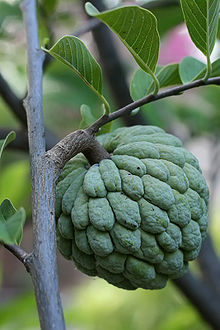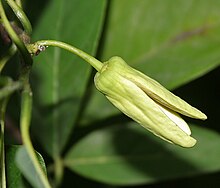| Annona squamosa | |
|---|---|
 | |
 | |
| Sugar-apple | |
| Scientific classification | |
| Kingdom: | Plantae |
| Clade: | Tracheophytes |
| Clade: | Angiosperms |
| Clade: | Magnoliids |
| Order: | Magnoliales |
| Family: | Annonaceae |
| Genus: | Annona |
| Species: |
A. squamosa
|
| Binomial name | |
| Annona squamosa | |
| Synonyms | |
Annona squamosa is a small, well-branched tree or shrub[6] from the family Annonaceae that bears edible fruits called sugar-apples or sweetsops. It tolerates a tropical lowland climate better than its relatives Annona reticulata and Annona cherimola[5] (whose fruits often share the same name)[2] helping make it the most widely cultivated of these species.[7] Annona squamosa is a small, semi-(or late) deciduous,[8] much branched shrub or small tree 3 metres (9.8 ft)[6] to 8 metres (26 ft) tall[8] similar to soursop (Annona muricata).[9]in India madhyapradesh this tree known as sitafal tree
Contents
Description[edit]
The fruit of A. squamosa (sugar-apple) has sweet whitish pulp, and is popular in tropical markets.[8]
- Stems and leaves
- Branches with light brown bark and visible leaf scars; inner bark light yellow and slightly bitter; twigs become brown with light brown dots (lenticels – small, oval, rounded spots upon the stem or branch of a plant, from which the underlying tissues may protrude or roots may issue).[5]
- Thin, simple, alternate leaves[9] occur singly,[5] 5 centimetres (2.0 in) to 17 centimetres (6.7 in) long and 2 centimetres (0.79 in)[8] to 6 centimetres (2.4 in) wide;[5] rounded at the base and pointed at the tip (oblong-lanceolate).[8] Pale green on both surfaces and mostly hairless[5] with slight hairs on the underside when young.[6] The sides sometimes are slightly unequal and the leaf edges are without teeth, inconspicuously hairy when young.[5][9]
- Leaf stalks are 0.4 centimetres (0.16 in) to 2.2 centimetres (0.87 in)[8] long, green, and sparsely pubescent.[5]
- Flowers
- Solitary or in short lateral clusters of 2–4 about 2.5 centimetres (0.98 in) long,[8] greenish-yellow flowers on a hairy, slender[5] 2 centimetres (0.79 in) long stalk.[8] Three green outer petals, purplish at the base, oblong, 1.6 centimetres (0.63 in) to 2.5 centimetres (0.98 in) long, and 0.6 centimetres (0.24 in) to 0.75 centimetres (0.30 in) wide, three inner petals reduced to minute scales or absent.[6][8] Very numerous stamens; crowded, white, less than 1.6 centimetres (0.63 in) long; ovary light green. Styles white, crowded on the raised axis. Each pistil forms a separate tubercle (small rounded wartlike protuberance), mostly 1.3 centimetres (0.51 in) to 1.9 centimetres (0.75 in) long and 0.6 centimetres (0.24 in) to 1.3 centimetres (0.51 in) wide which matures into the aggregate fruit.[5]
- Flowering occurs in spring-early summer[8] and flowers are pollinated by nitidulid beetles.[10] Its pollen is shed as permanent tetrads.[11]
- Fruits and reproduction
- Aggregate and soft fruits form from the numerous and loosely united pistils of a flower[5] which become enlarged[8] and mature into fruits which are distinct from fruits of other species of genus[5] (and more like a giant raspberry instead).
- The round or heart-shaped[5] greenish yellow, ripened aggregate fruit is pendulous[8] on a thickened stalk; 5 centimetres (2.0 in)[5][6] to 10 centimetres (3.9 in) in diameter[8][9] with many round protuberances[5] and covered with a powdery bloom. Fruits are formed of loosely cohering or almost free carpels (the ripened pistels).[6]
- The pulp is white tinged yellow,[6] edible and sweetly aromatic. Each carpel containing an oblong, shiny and smooth,[5] dark brown[6] to black, 1.3 centimetres (0.51 in) to 1.6 centimetres (0.63 in) long seed.[5]
Distribution[edit]
Annona squamosa is native to the tropical Americas and West Indies, but the exact origin is unknown. It is now the most widely cultivated of all the species of Annona, being grown for its fruit throughout the tropics and warmer subtropics, such as Indonesia, Thailand, and Taiwan; it was introduced to southern Asia before 1590. It is naturalized as far north as southern Florida in the United States and as south as Bahia in Brazil, Bangladesh, and is an invasive species in some areas.[5][7][9]
- Native
- Neotropic
- Caribbean: Antigua and Barbuda, Bahamas, Barbados, Cuba, Dominica, Dominican Republic, Grenada, Guadeloupe, Haiti, Jamaica, Martinique, Montserrat, Netherlands Antilles, Puerto Rico, St Kitts and Nevis, St Lucia, St Vincent and the Grenadines, Surinam, Trinidad and Tobago, Virgin Islands.
- Central America: El Salvador Guatemala
- Northern South America: Suriname, French Guiana, Guyana, Venezuela
- Western South America: Bolivia, Colombia, Ecuador, Peru
- Southern South America: Argentina, Brazil, Chile, Paraguay, Uruguay[5]
- Current (naturalized and native)
- Neotropic
- Caribbean: Antigua and Barbuda, Bahamas, Barbados, Cuba, Dominica, Dominican Republic, Florida, Grenada, Guadeloupe, Haiti, Jamaica, Martinique, Montserrat, Netherlands Antilles, Puerto Rico, St Kitts and Nevis, St Lucia, St Vincent and the Grenadines, Surinam, Trinidad and Tobago, Virgin Islands.
- Pacific: Samoa, Tonga
- North America: Mexico
- Central America: Belize, Costa Rica, El Salvador, Guatemala, Honduras, Nicaragua, Panama
- Northern South America: French Guiana, Guyana, Venezuela
- Western South America: Bolivia, Colombia, Ecuador, Peru
- Southern South America: Argentina, Brazil, Chile, Paraguay, Uruguay
- Afrotropic: Angola, Sudan, Tanzania, Uganda, Zanzibar, Kenya
- Australasia: Australia, Fiji, New Zealand, Papua New Guinea, Solomon Islands
- Indomalaya: Bangladesh, Cambodia, China, India, Indonesia, Laos, Malaysia, Nepal, Pakistan, Philippines, Sri Lanka, Thailand, Vietnam
- Palearctic: Cyprus, Greece, Malta[5], Israel
Climate and cultivation[edit]
Like most species of Annona, it requires a tropical or subtropical climate with summer temperatures from 25 °C (77 °F) to 41 °C (106 °F), and mean winter temperatures above 15 °C (59 °F). It is sensitive to cold and frost, being defoliated below 10 °C (50 °F) and killed by temperatures of a couple of degrees below freezing. It is only moderately drought-tolerant, requiring at least 700 mm of annual rainfall, and will not produce fruit well during droughts.
It will grow from sea level to 2,000 metres (6,600 ft) and does well in hot dry climates, differing in its tolerance of lowland tropics from many of the other fruit bearers in the Annona family.
It is quite a prolific bearer, and it will produce fruit in as little as two to three years. A five-year-old tree can produce as many as 50 sugar apples. Poor fruit production has been reported in Florida because there are few natural pollinators (honeybees have a difficult time penetrating the tightly closed female flowers); however, hand pollination with a natural fiber brush is effective in increasing yield. Natural pollinators include beetles (coleoptera) of the families Nitidulidae, Staphylinidae, Chrysomelidae, Curculionidae and Scarabeidae.[7][12]
In the Philippines, the fruit is commonly eaten by the Philippine fruit bat (kabag or kabog), which then spreads the seeds from island to island.
It is a host plant for larvae of the butterfly Graphium agamemnon (tailed jay).
Uses[edit]
In traditional Indian, Thai, and American medicine, the leaves are used in a decoction to treat dysentery and urinary tract infection.[13] In traditional Indian medicine, they are also crushed and applied to wounds.[13] In Mexico, the leaves are rubbed on floors and put in hens' nests to repel lice.[7]
Chemical constituents[edit]
The diterpenoid alkaloid atisine is the most abundant alkaloid in the root. Other constituents of Annona squamosa include the alkaloids oxophoebine,[14] reticuline,[14] isocorydine,[15] and methylcorydaldine,[15] and the flavonoid quercetin-3-O-glucoside.[16]
Bayer AG has patented the extraction process and molecular identity of the annonaceous acetogenin annonin, as well as its use as a biopesticide.[17] Other acetogenins have been isolated from the seeds,[18] bark,[19] and leaves.[citation needed]




Nenhum comentário:
Postar um comentário